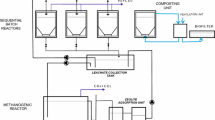Summary
Biomethanation in Argentina is considered for the treatment of agro-industrial wastes, to reduce pollution and costs of wastewater treatment, and for the treatment of animal manure in locations far away from the energy-distribution systems. For the treatment of stillage the Upflow Anaerobic Sludge Blanket (UASB) reactor has been retained on the basis of the results obtained in a 100-litre semi-pilot-plant reactor. A 30-m3 UASB pilot plant is to be built in a leading distillery. The expected production of a full-scale plant would cover, 65 to 70% of the energy needs of the distillery. In biomethanation of manure, the only farms that could profit from biogas technology are the milking farms located far away from the electricity distribution system where the manure collected during the milking time could produce the energy needed to cool the milk from 22°C to 4°C.
Résumé
En Argentine la biométhanisation est essentiellement prise en compte d'une part pour le traitement des eaux résiduaries des agro-industries, pour réduire la pollution et le coût de traitement des ces déchets, et d'autre part pour le traitement de lisiers animaux dans des régions éloignées du réseau de distribution d'énergie. En ce qui concerne le traitement des eaux résiduaires, le procédé Upflow Anaerobic Sludge Blanket (UASB) a été retenu sur base des résultats obtenus dans un digesteur pilote de 100 1. Une installation pilote de 30 m3 sera construite dans une distillerie importante susceptible de couvrir 65 à 75% de ses besoins énergétiques avec la production attendue d'une installtion de taille réelle. En ce qui concerne la biométhanisation de lisier, les seules exploitations qui tireraient profit de la technologie sont les élevages laitiers situés loin du réseau de distribution d'électricité, où le lisier récolté pendant la traite pourrait produire l'énergie suffisant au refroidissement du lait.
Resumen
En Argentina se usa la biometanación para el tratamiento de residuos agro-industriales, para reducir los niveles de polución y el coste de tratamiento de aguas residules y para el tratamiento de estiercol animal en lugares lejanos de la red de distribución energética. Debido a los resultados obtenidos en un reactor semi-piloto de 100 litros se sigue utilizando el UASB para el tratamiento de los desechos de destileria. Se va a construir una planta piloto UASB en una de las destilerias más importantes. Las expectativas de producción cubren du un 65% a un 70% de las necesidades energéticas de la destileria. En relación con la biometanación de estiercol las únicas explotaciones agrarias que podrían beneficiarse de la tecnología del biogas son las granjas lecheras localizadas lejos de la red de distribución electrica donde el estiercol recogido durante el tiempo de ordeñe podría producir la energía necesaria para enfriar la leche de 22°C a 4°C.
Similar content being viewed by others
References
Boone, D.R. &Bryant, M.P. 1980 Propionate degrading bacterium,Syntrophobacter wolinii sp. nov. gen. nov. from methanogenic ecosystemsApplied and Environmental Microbiology 40, 626–632.
Cordoba, P.R., Sanchez-Riera, F. &Sineriz, F. 1982 Possibilities of energy recovery in alcohol distilleries of Argentina. InInternational Seminar Proceedings: Energy Conservation and Use of Renewable Energies in the Bio-industries, ed. Vogt, F., pp. 196–202. London: Pergamon Press.
Hobson, P.N. 1981 Microbial pathways and inteactions in the anaerobic treatment process. InMixed Culture Fermentation eds. Bushell, M.E. and Slater, J.H., pp. 54–59. London: Academic Press.
Kohli, H.S. 1980 Renewable Energy: Alcohol from Biomass. Finance and Development. (Report.) December, 1980. Washington: World Bank.
Lettinga, G., van Velsen, A.F.M., Hobma, S.W., de Zeeuw, W. &Klapwijk A. 1980 Use of the upflow sludge blanket reactor concept for biological wastewater treatment, especially for anaerobic treatment.Biotechnology and Bioengineering 22, 699–734.
Lettinga, G., Roersma, R. &Grin P. 1983 Anerobic treatment of raw domestic sewage at ambient temperature using a granular bed UASB reactor.Biotechnology and Bioengineering 25, 1701–1723.
Sanchez-Riera, F., Valz-Gianinet, S., Callieri, D.A.S. & Sineriz, F. 1982 Use of a packedbed reactor for anaerobic treatment of stillage of sugar cane molasses.Biotechnology Letters 4, 127–132.
Sanchez-Riera, F., Cordoba, P.R. &Sineriz, F. 1985 Use of the UASB reactor for the anaerobic treatment of stillage from sugar cane molasses.Biotechnology and Bioengineering 27, 1710–1716.
Sineriz, F., Diaz, H.F., Cordoba, P.R. &Sanchez-Riera, F. 1983 Continuous production of methane from stillage. InAvances en Digestion Anaerobica. ICAITI, Guatemala: Mircen-Biotecnologia.
Valdez Gimenez, E., Obaya-Abreu, M.C. &Garcia Pena, A. 1983 Treatment of waste from the alcohol industry. InAvances en Digestion Anaerobica. ICAITI, Guatemala: Mircen-Biotecnologia.
van Broock, M.R.G. de 1984 Industrial fermentation ethanol production in South America.CRC Critical Reviews in Biotechnology 1 (3), 209–228.
Villen, R.A., Craveiro, A.M., Goncalves, A.C.R. &Iglesia, M.R.D.L. 1985Third EC Conference Energy from Biomass: Anaerobic Treatment of Organic Residues. Vinasse Treatment. Fundazione Cini, Venezia, Italia.
Young, J.C. & Dahab, M.F. 1982 Effect of media design on the performance of fixed bed anaerobic reactors.Proceedings of the International Association on Water Pollution, Research Seminar on Anaerobic Treatment of Wstewater in Fixed Film Reactors, Department of Sanitary Engineering, University of Denmark, Copenhagen.
Author information
Authors and Affiliations
Rights and permissions
About this article
Cite this article
Sineriz, F. Report on the use of biomethanation in Argentina. Mircen Journal 4, 143–149 (1988). https://doi.org/10.1007/BF00936829
Issue Date:
DOI: https://doi.org/10.1007/BF00936829




